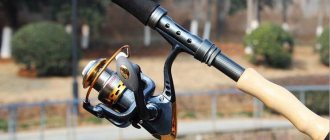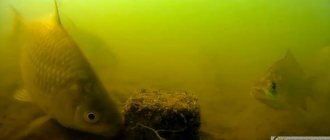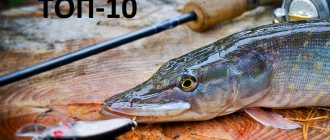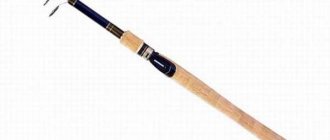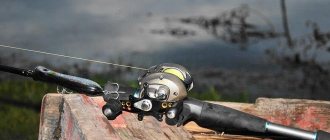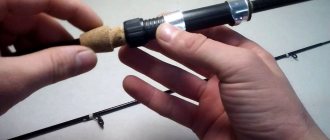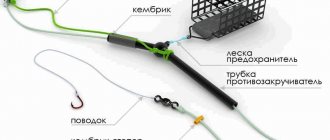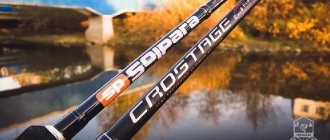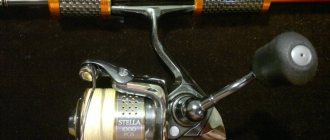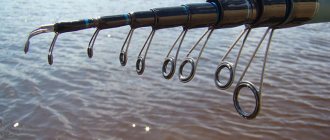A telescopic fishing rod is one of the most common and popular fishing gear today. Every fisherman has a telescopic fishing rod in his arsenal of fishing equipment, or even more than one, which will help out in many fishing situations, providing the necessary comfort and reliability of fishing. This kind of rod is suitable for catching almost all types of fish, including predator prey, with certain methods of equipping the tackle. It will not be surprising that at present, the fishing hobby of novice anglers begins with the acquisition of telescopic gear, a universal tool for most fishing conditions.
Affordability in terms of cost and a wide selection of rod options only contribute to the popularization of float hunting, which over time does not become less interesting and productive than other fishing methods. The article will be devoted to a review of a telescopic fishing rod, which will give direction in choosing gear based on the features of its structure and the operating parameters of the form, and the fisherman will also learn about the most popular models of the tool today, which will be presented in the form of a small rating.
Types of telescopic fishing rods
Telescopic fishing rods may differ in design from each other depending on the fishing method. To a greater extent, these differences depend on the fishing distance, which is influenced by the structure of the reservoir, and in particular, the availability of bait in the promising zone, as well as the specific behavior of the fish. As a rule, telescopes are used in conjunction with float rigs, with the help of which they catch various kinds of fish, which do not differ much in their dimensions and weight. Often this is quite dynamic fishing, requiring a large number of casts, hooking pecking fish and landing them, or better yet, lifting them out of the water.
But some methods are distinguished by the ambush method of hunting and in such cases, the fisherman only works with the gear for a short time, the vast majority of which is spent on observing the signals of the float. It was the bait supply distances and fishing dynamics that divided the gear into two types, which differ significantly in design features and have unique performance characteristics that can satisfy current fishing conditions. Our further conversation will be about the multidirectionality of gear.
Bolognese
The Bolognese telescopic rod is the most common type of gear. It can be considered a universal tool for fishing with float rigs. But the original purpose of the bolognese was to catch medium distances, in bodies of water with a current, and it was precisely for these conditions that the tackle was invented. A bolonka is a fishing rod with sizes from 4 to 9 meters consisting of 5–9 legs. The main distinguishing feature of the tackle from a classic fishing rod is the presence of guide rings on the form, which are located at the top of each bend of the tool, and the quivertip is equipped with three rings, two of which move freely along the entire length of the tip of the tackle.
A bologna is a rod and reel. Its inertial or inertial-free type is a mandatory attribute of the gear. And the role of the reel is not only in storing fishing line, but also in ensuring the range of bait delivery, as well as minimizing difficulties when landing caught fish due to the settings of the friction brake of the mechanism. This type of fishing equipment is distinguished by its lightweight form, which allows for high-speed and dynamic fishing of small and medium-sized fish at medium and short hunting distances, at various depths in both calm and windy weather and high waves.
Fly feathers
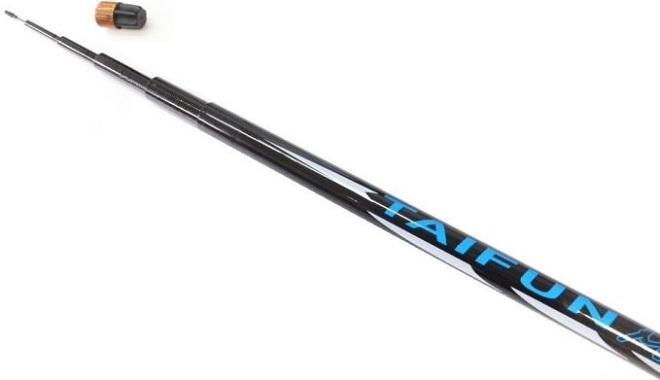
The fly rod is a classic fishing tackle, which is the prototype of almost all types of modern fishing rods. A special feature of the tool is the minimum number of auxiliary attributes on the tackle form. As a rule, fly tackle consists only of the whip itself, without winding rings or line storage. The equipment is mounted to the quiver type of tackle using a connector immediately before fishing and is completely changed when conditions change to a different type. The swing length can vary from 2 to 10 meters, and the number of telescopic knees can reach up to a dozen pieces.
Important! A fly rod is used to fish short distances at depths not exceeding the length of the gear.
The dynamics of fishing can vary in intensity, depending on the activity of the fish, its type and the fishing strategy itself. In some cases, for the convenience of storing fishing line, fishermen equip the butt of the fishing rod with a reel or a small-diameter inertial reel, which always has a small supply of cord and helps quickly bring the equipment into working condition or assemble it after fishing.
How to choose a telescopic fishing rod with and without rings
A telescopic fishing rod is one of the most common and popular fishing gear today. Every fisherman has a telescopic fishing rod in his arsenal of fishing equipment, or even more than one, which will help out in many fishing situations, providing the necessary comfort and reliability of fishing. This kind of rod is suitable for catching almost all types of fish, including predator prey, with certain methods of equipping the tackle. It will not be surprising that at present, the fishing hobby of novice anglers begins with the acquisition of telescopic gear, a universal tool for most fishing conditions.
Affordability in terms of cost and a wide selection of rod options only contribute to the popularization of float hunting, which over time does not become less interesting and productive than other fishing methods. The article will be devoted to a review of a telescopic fishing rod, which will give direction in choosing gear based on the features of its structure and the operating parameters of the form, and the fisherman will also learn about the most popular models of the tool today, which will be presented in the form of a small rating.
Telescopic fishing rods may differ in design from each other depending on the fishing method. To a greater extent, these differences depend on the fishing distance, which is influenced by the structure of the reservoir, and in particular, the availability of bait in the promising zone, as well as the specific behavior of the fish. As a rule, telescopes are used in conjunction with float rigs, with the help of which they catch various kinds of fish, which do not differ much in their dimensions and weight. Often this is quite dynamic fishing, requiring a large number of casts, hooking pecking fish and landing them, or better yet, lifting them out of the water.
But some methods are distinguished by the ambush method of hunting and in such cases, the fisherman only works with the gear for a short time, the vast majority of which is spent on observing the signals of the float. It was the bait supply distances and fishing dynamics that divided the gear into two types, which differ significantly in design features and have unique performance characteristics that can satisfy current fishing conditions. Our further conversation will be about the multidirectionality of gear.
The Bolognese telescopic rod is the most common type of gear. It can be considered a universal tool for fishing with float rigs. But the original purpose of the bolognese was to catch medium distances, in bodies of water with a current, and it was precisely for these conditions that the tackle was invented. A bolonka is a fishing rod with sizes from 4 to 9 meters consisting of 5–9 legs. The main distinguishing feature of the tackle from a classic fishing rod is the presence of guide rings on the form, which are located at the top of each bend of the tool, and the quivertip is equipped with three rings, two of which move freely along the entire length of the tip of the tackle.
A bologna is a rod and reel. Its inertial or inertial-free type is a mandatory attribute of the gear. And the role of the reel is not only in storing fishing line, but also in ensuring the range of bait delivery, as well as minimizing difficulties when landing caught fish due to the settings of the friction brake of the mechanism. This type of fishing equipment is distinguished by its lightweight form, which allows for high-speed and dynamic fishing of small and medium-sized fish at medium and short hunting distances, at various depths in both calm and windy weather and high waves.
The fly rod is a classic fishing tackle, which is the prototype of almost all types of modern fishing rods. A special feature of the tool is the minimum number of auxiliary attributes on the tackle form. As a rule, fly tackle consists only of the whip itself, without winding rings or line storage. The equipment is mounted to the quiver type of tackle using a connector immediately before fishing and is completely changed when conditions change to a different type. The swing length can vary from 2 to 10 meters, and the number of telescopic knees can reach up to a dozen pieces.
Important! A fly rod is used to fish short distances at depths not exceeding the length of the gear.
The dynamics of fishing can vary in intensity, depending on the activity of the fish, its type and the fishing strategy itself. In some cases, for the convenience of storing fishing line, fishermen equip the butt of the fishing rod with a reel or a small-diameter inertial reel, which always has a small supply of cord and helps quickly bring the equipment into working condition or assemble it after fishing.
The design of a telescopic fishing rod is not complicated in design. The standard rational but functional set of the rod consists of a blank, tackle handle, reel seat and guide rings. The design of these types of fishing rods is based on the principle of operation of a telescope, when each successive part of the product in diameter allows you to hide a smaller element within itself, thus bringing a long fishing rod to an assembled form, not exceeding in size 0.7-1 .5 meters.
The so-called camping mini-models can be much smaller when folded and fit into the butt of a fishing rod measuring up to half a meter or less. Let's look at the components of the gear in more detail.
Depending on its length, the rod blank can consist of three to ten independent sections or elbows. Each elbow is sequentially connected to each other by pulling the element through the largest section, followed by rigid fixation due to the difference in diameters at the joint of the tackle. Like a nesting doll, a decreasing element is pulled out from the first knee or butt of the rod until the tool is fully operational. Before the final fixation of the sections, they are rotated around their axis, aligning the passage rings on the same line, which is exactly how the assembly of the tool ends, taking only a dozen seconds.
Telescopic rod device
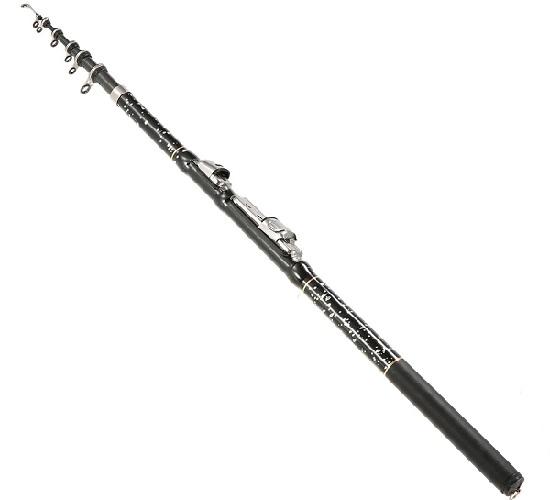
The design of a telescopic fishing rod is not complicated in design. The standard rational but functional set of the rod consists of a blank, tackle handle, reel seat and guide rings. The design of these types of fishing rods is based on the principle of operation of a telescope, when each successive part of the product in diameter allows you to hide a smaller element within itself, thus bringing a long fishing rod to an assembled form, not exceeding in size 0.7-1 .5 meters.
The so-called camping mini-models can be much smaller when folded and fit into the butt of a fishing rod measuring up to half a meter or less. Let's look at the components of the gear in more detail.
Form
Depending on its length, the rod blank can consist of three to ten independent sections or elbows. Each elbow is sequentially connected to each other by pulling the element through the largest section, followed by rigid fixation due to the difference in diameters at the joint of the tackle. Like a nesting doll, a decreasing element is pulled out from the first knee or butt of the rod until the tool is fully operational. Before the final fixation of the sections, they are rotated around their axis, aligning the passage rings on the same line, which is exactly how the assembly of the tool ends, taking only a dozen seconds.
To ensure the rigidity of the connections, each section in its upper part has a tightening ring, a clip that prevents the material from splitting and facilitates reliable fixation of the assembled fishing rod as a single solid product. The method of disassembling and folding is identical for a telescopic fishing rod, both without rings and with rings.
Passing rings

Passage rings are the lot of Bologna gear. All sections of the fishing rod are equipped with them at their top. As a rule, the telescopic tube is equipped with lightweight rings with a high leg. Ring inserts can vary in material from cheap plastic to stainless steel and ceramic materials. The diameters of the rings are proportional to the size of the knee, decreasing from the butt of the fishing rod to its quiver tip. The quivertype of tackle ends with the installation of a specific end ring called a tulip. The tulip is mounted at an angle of 120 degrees relative to the form. This feature helps set the exact direction of the line when casting.
In addition to installing the tulip, the thinnest link of the rod is equipped with sliding rings that lock onto the quiver tip when unfolding the tackle and help distribute the load evenly. The butt of the fishing rod may have a handle, which is made of cork or neoprene. Both types of material are ergonomic and can increase the comfort of fishing, but neoprene is considered a more practical material for telescopic versions of fishing rods and, as a rule, when selecting gear, it is worth giving preference to this artificial synthetic material.
Reel seat
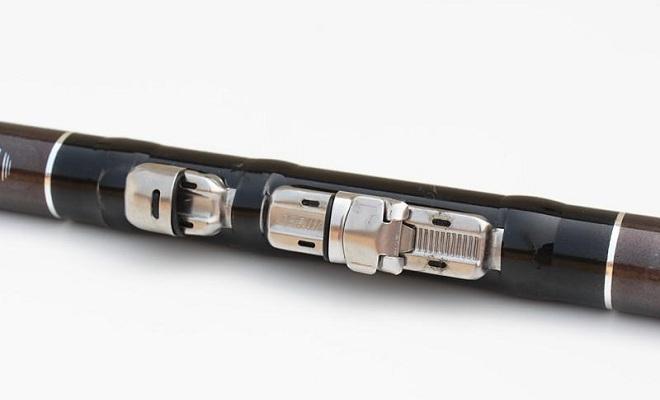
The Bolognese telescopic fishing rod with reel has in its design a device for mounting the mechanism or a reel seat. Screw clamping mechanisms are considered the simplest but most effective holder devices. By installing the support leg of the reel into special sliding clamps using a screw gear, the elements are clamped by hand, firmly connecting the reel and the tackle form. The screw mechanism is made of both plastic and lightweight metal alloys, which looks more reliable than plastic options.
Important! For a high-quality connection, reels are selected that correspond to the size of the leg and mechanism clamps, otherwise the tension will damage the clamps, and loose fastening will lead to backlash and unreliable operation of the gear.
Recently, a modernized Clip Up . This is a fast-acting device, without a screw gear. The device operates on the principle of clamping clips.
Whip
Depending on the material of manufacture and its properties, rod whips have different rigidity parameters, which affects the performance of the tackle when casting and playing fish. Sports whips are characterized by increased rigidity, which, with some skills, allows you to conduct high-speed fishing, making quick and reliable hooks even with long tackle.
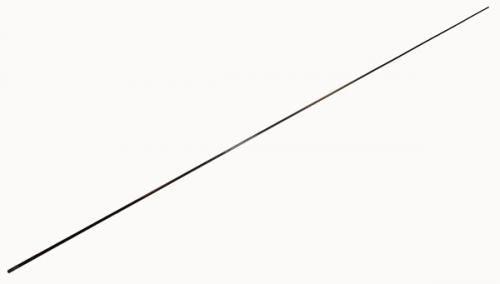
For amateurs, whips with medium stiffness parameters are better suited, which can be used to make long casts and at the same time not worry about overloads, which are effectively absorbed by the tackle. Soft whips are not effective for float rigs; they have low sensitivity and do not hook fish well, especially when fishing at high speed. Therefore, their use is only suitable for hunting large fish with wait-and-see hunting strategies, where overload compensation comes to the fore.
Types of telescopes
Telescopically connected models are used in various fishing directions to equip the following fishing rods:
- carp;
- fly floaters;
- Bolognese fishing rods;
- whales of plug gear;
- spinning rods;
- donk;
- feeders.
Attention! Even some winter fishing rods are made folding with telescopic knee joints.
Carp
Separately, we note that telescopes are also used in carp fishing. Only they often play an auxiliary role - as feeding or marker ones. Such powerful rods are also called surf rods and are used in sea fishing when long-distance power casting is needed.
Carp rods intended directly for fishing, as a rule, are connected with a plug. Although many amateur fishermen are quite successful at catching carp with ordinary four-meter telescopes, this is no longer carp fishing.
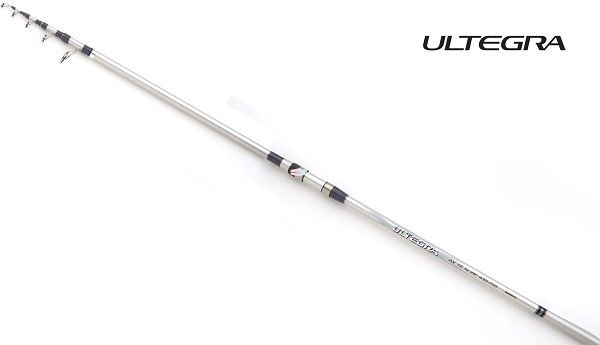
Shimano Ultegra surf rod.
Fly feathers
Flying rods are usually called telescopic float rods without rings. The length can be small, for example, in the bunk version, from one and a half to 3 m. But most often we are dealing with larger sizes: from 5 meters to 12.
The fly rod is not equipped with a reel seat; the fishing line is attached directly to the tip of the rod. There are several installation options:
- using a glued ring;
- through a forest loop;
- via a connector.
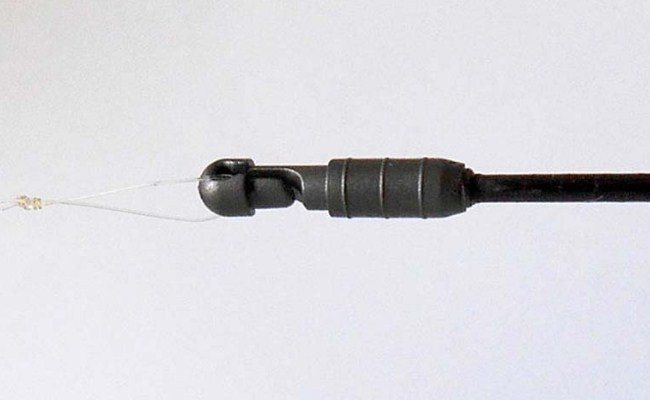
The connector is glued to the tip of the last knee with second glue.
Attention! The longer the rod, the more legs it has.
Flying rods are the lightest of their kind due to the absence of guides. It is these forms that are also used for such a popular type of fishing as side nod.
Bolognese
A telescopic rod with rings is most often used to equip a Bolognese rod. Most often this is a form 4 meters long.
The rod is equipped with guide rings. They are located at the end of each knee, and decrease in diameter from the butt to the tip. Sometimes the design contains an additional ring, located on the last knee and moving along it.
The lap dog guides are installed on high legs, which prevents the line from sticking to the blank when fishing in wet weather. The inserts in them are made from modern materials: from ceramics to silicon carbide in the most advanced models.
At the end of the last knee there is a tulip - a ring coaxial with the rest of the rings on the form. It experiences the heaviest loads when casting and retrieving, so experienced fishermen carry spare ones. If a tulip breaks, it is easy to repair it; just remove the old one and heat the attachment point with a lighter. Glue the new element with instant glue.
The telescope with rings is equipped with a reel seat. Depending on the model, it may be a standard screw type, like most spinning rods or feeders, but there are also models with a quick clamp.
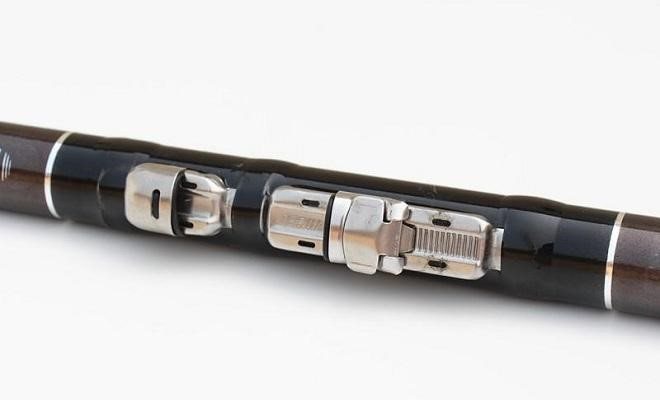
A reel seat of this design allows you to attach the reel more quickly.
Whales
The last sections of a plug float rod are called whales. They are about two meters long and are made in a telescopic version. A special feature of these forms is a shock-absorbing rubber band located inside the hollow telescope, to which the equipment is attached. This solution allows you to use the thinnest equipment, which is sometimes a decisive factor for success when fishing.
Spinning rods
Telescopic spinning rods are used mainly as travel models. They are compact, which allows you to take them with you on any trip. In addition, rods from well-known manufacturers are often placed in a tube for additional protection during transportation.
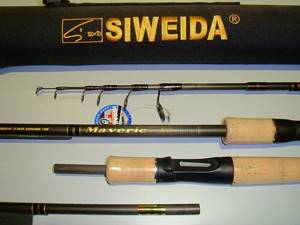
SWD MAVERIC spinning rod in a tube: compact and protected.
Telescopic spinning rods range in length from six to ten feet, which is similar to regular plug-in models. You can choose a rod for almost any type of fishing: from twitching in coastal thickets to boat jigging.
Donkey
Donks are most often mounted on four-meter telescopes designed for Bologna gear. The only difference is in the equipment of the fishing rods. At the same time, pendulum-type bite alarms are used to detect bites.
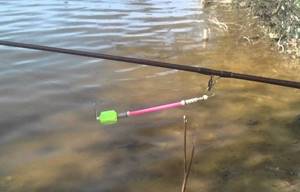
The rear part of the signaling device is attached to the access ring, the front part is hung on a fishing line.
Feeders
Feeders are also telescopic. This is an option for those same travelers. But unlike other fishing rods, there is a significant difference here - the rod cannot be completely assembled or disassembled by simply moving the knees.
The fact is that you can fully use the feeder only if you have a quivertip - a tip with increased sensitivity. It is even attached with a plug in the telescopic feeder.
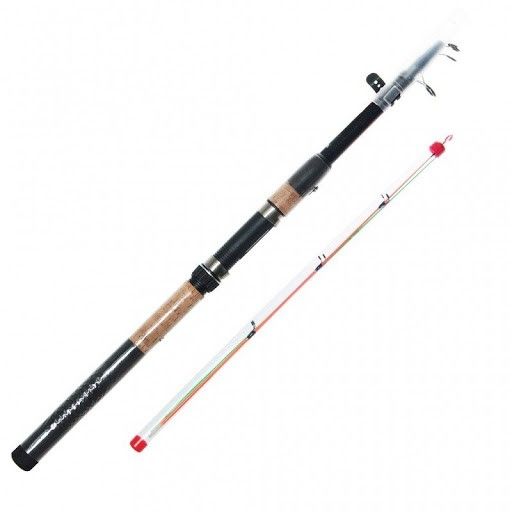
The telescope feeder kit includes a set of multi-colored quivertypes.
Quivertypes are divided according to their structure, as indicated by the inscriptions on them. If there are none, then you should look at the markings on the rod itself, and check the tips yourself. To do this, they are simultaneously taken by the tulip rings. The one that bends the most will correspond to the smaller test and vice versa.
Advantages and disadvantages of telescopes
The vast majority of peaceful fishing is done with telescopic fishing rods, and this is due to a number of significant advantages of the gear in contrast to other rod designs. First of all, this is the low cost and availability of this type of product. The second significant advantage lies in the compactness of the gear, which, when assembled, can be easily transported and stored at home without worrying about the lack of space for this. The telescope does not require special maintenance measures, and its operation is simple and does not require specific creation of conditions for comfortable fishing. The tackle forgives minor negligence in handling, serving for long fishing seasons without losing its working qualities.
The disadvantages include the low sensitivity of the fishing rod and the high weight of telescopic gear. Cheap models quickly lose rigidity in the joints of the knees, and the resulting backlash impairs the performance of long casts and, if the blank is unbalanced, leads to breakage of the upper knees when excess pressure appears from an incorrectly distributed load.
Advantages and disadvantages of telescopic rods
There is no single answer to the question of which is better – a telescopic rod or a plug rod. The choice depends on both the type of fishing and personal preferences. Flying rods are telescopic, while match and feeder rods are plug-in. The lap dogs are available in a telescopic version. Thus, when fishing with these tackles, the question of which design to choose practically does not arise.
But spinning rods come in both telescopic and plug-in types. And here it is worth carefully weighing the arguments for and against both options in order to decide on a purchase.
Advantages of telescopes
Telescopic rods have significant advantages that attract beginners and those who fish infrequently.
Compactness. When folded, many telescopes do not exceed half a meter in length. This is typical for spinning rods. Such rods are much more convenient to transport than plug-in, two-legged rods, which when disassembled are more than a meter long.
Cheapness. There are many inexpensive telescopic rods, primarily for spinning rods, but also for other types of fishing. Plug-in gear is usually more expensive.
Advantages of plugs
In many respects, plugs are superior to telescopic rods.
Build. If telescopic rods are almost always soft and lame, then the plugs often have an ultra-fast, fast or medium-fast action. These are rigid sticks that provide accurate casts and sharp hooks, and also allow you to confidently control the fish while playing. Plug-in fishing rods perform better on casting and retrieving than telescopic rods.
It is also important that rings can be placed at any points on the plug form. This is what manufacturers do; as a result, the load is distributed across the gear in an optimal way. In the case of a telescopic rod, the rings can only be located at the ends of the knees.
Sensitivity. The plugs better transfer into the hand everything that happens with the bait, which is especially important in spinning fishing. Telescopic fishing rods are inferior in this regard. Weight. With the same material of manufacture, the same length and the same number of guide rings, a telescopic rod will be heavier than a plug rod.
How to choose a telescopic fishing rod
You can select the best telescopic fishing rods if you have information on the working properties of the material from which the gear is made and according to the criteria of the planned fishing or those conditions that are most likely to occur during fishing. When deciding on a purchase, they study the markings applied to the form in the area of the first and second bends, where a reliable manufacturer will give out the full parameters of the gear. It is also worth unfolding the rod to its full length and visually inspecting the product for cracks in the material of the knees and chips in the ring liners. The rigidity of the rod is checked by shaking the blank, while feeling the elasticity of the whip, without dips or play in the joints. We will consider the nuances of selection according to the main criteria below.
Material of manufacture
Telescopes can be made from both heavy fiberglass and light graphite. Of course, heavy fiberglass is not very comfortable for dynamic high-speed fishing and is more suitable for fly gear for ambush hunting strategies. Graphite, on the contrary, is comfortable to fish, but is quite fragile and at the same time has a high price. The best option when buying a telescopic rod would be to look for gear marked carbon. This is not a heavy rod with high strength qualities and an affordable price. Carbon tackle is not afraid of small shock loads and can withstand critical bends due to its high plastic properties. Recommended for both beginners and experienced fishermen.
Length
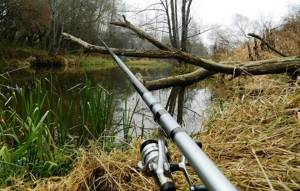
The length of the fishing rod is selected taking into account the fishing capabilities of certain distances. Fishermen determined the standard size of tackle for float rigs to be 6–7 meters long. Fishing at short distances is covered with rods with a blank length from 2 to 5 meters. Specific rods for fishing at medium and long distances are variants of tools with a length of 9 meters. As a rule, this is a fishing rod without rings, for an ambush strategy for catching medium and large peaceful fish.
Build
The rod structure is chosen based on the intensity of fishing. For high-speed fishing, select a rod with a fast or semi-fast action. Such tools are loved by sports fishermen with advanced techniques for casting and hooking fish.
Important! A universal tool for a float fishing enthusiast would be to purchase a telescopic carbon fishing rod with a medium action.
When loaded, its form will bend to the middle without any consequences for the integrity of the tackle. Slow-speed telescopes are practically never found on sale, and their practical use is quite rarely suitable for float fishing strategies.
Choosing a telescope
Let's consider the main types of manufacturing materials: • The most economical options for such fishing rods include the model range made from fiberglass. This type of spinning rod is relatively durable. • Composite version of the telescope. It is made from a mixture of fiberglass and carbon additives, as a result of which the strength characteristics of the models increase. • Carbon fiber variation. Currently, they are in extraordinary demand among fishermen, as they have high strength and incredible sensitivity. These properties allow the angler to perfectly catch large fish. • Ultralight look. A compact spinning rod of this type is made from carbon fiber. It uses ultra-small baits and thin fishing lines.
The best telescopic fishing rods
To conclude the material, we will give a rating of the most popular telescopic fishing rods, recommended for purchase or selection of a similar analogue.
- The leader in the ratings of telescopic gear is the flywheel model from Shimano, the legendary Catana EX TE 2-600 . An ultra-light, compact carbon fiber fishing rod with a test range of 5 to 10 grams that works in all weather conditions. Balanced tackle is capable of fighting large trophies, characterized by effective damping of overloads.
- Not far behind in popularity is the rod from Salmo - Sniper Pole Medium . The tackle is ideal for high-speed fishing at short distances, featuring a high sensitivity quiver tip, lightness and ergonomic handle. It is in the budget price range.
- The third on the list is the domestic fly fishing rod Sabaneev Master Pole 600 . It may be a little heavy, but the reliability of the rigid composite blank during dynamic fishing makes up for all the shortcomings with strength and confidence in catching the largest trophies. And the cost of the gear pleases with its affordable price.
- We give the fourth line to Atemi Classix Bolognese 6.0M . To a large extent, the high position of the model was assigned for the strength of the rod, which is recommended for a novice fisherman to master the technique of fishing with Bolognese tackle. In addition, the low price and skillfully made protective case will delight the fisherman who becomes the owner of this tool.
- Rounding out the top five is the stylish and practical tackle from Black Hole Atomic Bolo 700 . The high quality of workmanship and perfect balance of the seven-meter rod will please the experienced floater who knows a lot about Bolognese with comfortable fishing. The price of buying a masterpiece is a little constraining, but if you have the desire and perseverance, having acquired such a product, all you have to do is enjoy the fishing process, having a constant, stable catch.
